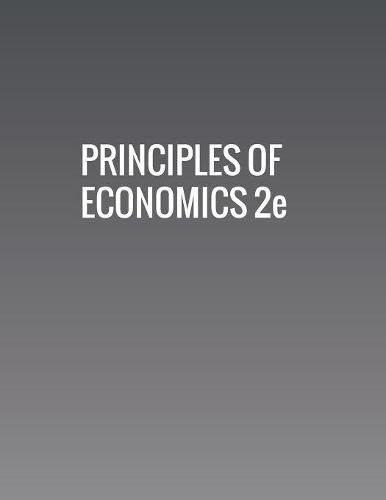
Imagine that the government reworks the welfare policy that was affecting Jonathan in question 1, so that for each dollar someone like Jonathan earns at work, his government benefits diminish by only 30 cents. Reconstruct the table from question 1 to account for this change in policy. Draw Jonathan’s labor-leisure opportunity sets, both for before this welfare program is enacted and after it is enacted.
Want to see the full answer?
Check out a sample textbook solution
Chapter 15 Solutions
Principles Of Economics 2e
Additional Business Textbook Solutions
Financial Accounting, Student Value Edition (5th Edition)
Intermediate Accounting (2nd Edition)
Horngren's Financial & Managerial Accounting, The Financial Chapters (Book & Access Card)
Gitman: Principl Manageri Finance_15 (15th Edition) (What's New in Finance)
Business Essentials (12th Edition) (What's New in Intro to Business)
Corporate Finance (4th Edition) (Pearson Series in Finance) - Standalone book
- HW Ch5 Calculate the daily total revenue when the market price is $180, $160, $140, $120, $100, $80, $60, and $40 per bippitybop. Then, use the green point (triangle symbol) to plot the daily total revenue against quantity corresponding to these market prices on the following graph. 2 @ 3840 3520 3200+ 2880 2560+ 2240 TOTAL REVENUE (Dollars) 1920 1600 1280 960 + 640+ 0 0 8 16 24 32 40 48 56 64 72 80 QUANTITY (Bippitybops per day) Total Revenue ? According to the midpoints formula, the price elasticity of demand between points A and B on the initial graph is approximately . Suppose the price of bippitybops is currently $60 per bippitybop, shown as point A on the initial graph. Because the price elasticity of demand between points A and B is , a $20-per-bippitybop decrease in price will lead to MacBook Air in total revenue per day. F2 80 F3 #3 $ 4 5 6 F6 < F7 * 8 & 27 DII 8 F8 F9 F10 61 0 W E R T Y U 0 P S D LL F G H J K Larrow_forwardNot use ai pleasearrow_forwardChina is a leader in international trade, has one of the highest GDPs, and currently holds the largest foreign exchange reserve in the world. Is it fair for China to fix its currency by undervaluing it on the market? How does keeping its currency undervalued give it a favorable position in international trade? What about from the viewpoints of international companies and consumers?arrow_forward
- Explain the requirements of the states that have enacted legislation to protect taxpayers from predatory tax return preparers and tax refund advances.arrow_forwardResponsd to Luis Rodriguez 1800 tons of pomegranates a year is a lot of sweetness! So, you can get 71 Afghanis for $1? How cool. Does that mean you can buy a lot of stuff in Afghanistan for only $1? How do you know that your purchasing power in Afghanistan is stronger than in the United States? Yes, with an exchange rate of 71 Afghan Afghani for 1 US dollar, you can buy many things in Afghanistan for just $1. However, purchasing power isn't solely determined by the exchange rate. It also depends on the cost of goods and services in each country. For example, if a meal in Afghanistan costs 200 Afghanis, you would need about $2.82 to buy that meal in US dollars (since 200 Afghanis divided by 71 Afghanis per dollar equals approximately $2.82). So, while the exchange rate allows you to get more Afghanis for your dollars, you also need to consider how much things cost in Afghanistan. Now that the world seems to like Afghani stuff and is buying more of it, does that mean your…arrow_forwardThe idea that a country can experience gains from trade means that it can A) consume at a point outside its production possibilities frontier. B) increase its exports. C) increase the efficiency of its production. D) experience a bowed-out production possibilities frontier.arrow_forward
 Economics (MindTap Course List)EconomicsISBN:9781337617383Author:Roger A. ArnoldPublisher:Cengage Learning
Economics (MindTap Course List)EconomicsISBN:9781337617383Author:Roger A. ArnoldPublisher:Cengage Learning


 Managerial Economics: A Problem Solving ApproachEconomicsISBN:9781337106665Author:Luke M. Froeb, Brian T. McCann, Michael R. Ward, Mike ShorPublisher:Cengage Learning
Managerial Economics: A Problem Solving ApproachEconomicsISBN:9781337106665Author:Luke M. Froeb, Brian T. McCann, Michael R. Ward, Mike ShorPublisher:Cengage Learning Exploring EconomicsEconomicsISBN:9781544336329Author:Robert L. SextonPublisher:SAGE Publications, Inc
Exploring EconomicsEconomicsISBN:9781544336329Author:Robert L. SextonPublisher:SAGE Publications, Inc





